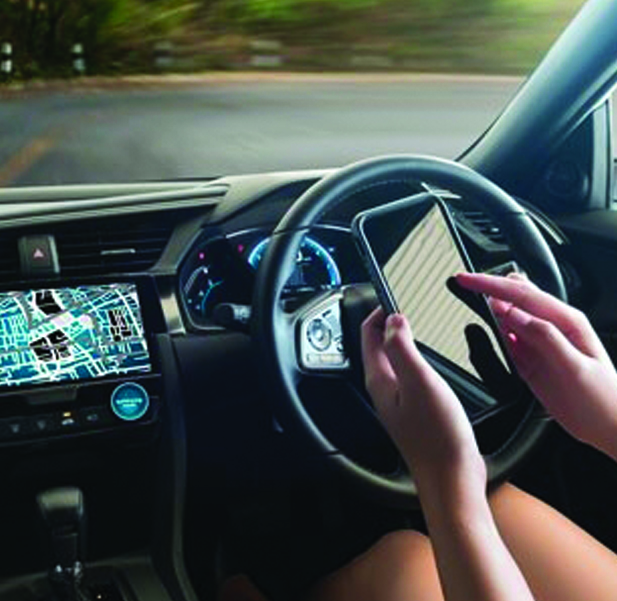With all the talk at the moment of self-driving cars that in a few years will free us from having to drive ourselves and let us get from one part of town to another with ease, we tend to forget that the cars we drive today are partly autonomous already. Some examples include automatic braking systems that recognise when the vehicle in front of you is too close, speed assistance that regulates speed having autonomously interpreted roadside traffic signs, and sensors that monitor the lines between lanes, intervening directly if we're about to go in the wrong one.
These systems are a key part of the process that will lead to cars becoming more and more autonomous. But they're not just that. They're going to make cars even more connected and integrated with the Internet of Everything.
Cars connected to the network will let us see weather and traffic conditions, constantly and in real time. We will know at all times where our cars are and where the nearest parking space is, and we'll be able to keep track of the condition of the brakes and engine.
The role of 5G
Cars will essentially become a full technological platform, capable of running complete infotainment systems and offering ever more advanced services.They'll benefit from sensors, big data analysis and AI algorithms. But the glue that really holds all this together is 5G, the new mobile data transmission technology that will become a reality in 2019. Among other things, it will revolutionise mobility. The broadband speed of 5G is one of its most important features. Reaching up to 1 GB per second, it will be able, to give just one example, to provide our car entertainment systems with video in top-quality resolution. But its low latency is what's really going to change what cars can do. The time it takes for two devices to connect today is 20-40 milliseconds.With 5G, it will go down to 2-4 milliseconds. And it doesn't just affect technology. Low latency will allow our car sensors to communicate instantly with those of other cars and in real time with traffic lights, roadside traffic signs and all the other urban features that will be connected to the network in future.
This is a crucial aspect for marketing self-driving cars, which won't just have to rely on their sensors to interpret what's going on around them. They'll be able to communicate with the surrounding world, adjusting their speed to traffic lights, signalling their position to nearby vehicles and checking traffic in real time. Plus, connected cars will drastically reduce congestion by driving on parallel routes to make sure traffic is spread evenly, which will in turn reduce fuel waste.Another important advantage is the potential for reducing accidents, 90% of which today are caused by human error. They are gradually decreasing as connected cars are evolving into self-driving cars. The possibilities for social inclusion should be mentioned as well. With AI driving vehicles, sections of society now excluded from this kind of mobility will be able to benefit from cars, be they older adults, disabled persons or others.
The Smart Road project is the first fully Italian experiment with self-driving cars. The Municipality of Turin, in partnership with TIM, is applying to become the first city in Italy to test self-driving cars in an urban environment. Turin is particularly suitable because of its technological infrastructures, which include fibre optics and traffic detection systems (sensors at traffic lights, indicators under the tarmac that detect passing vehicles to get an overview of the traffic in real time, and intelligent cameras at intersections).The city is working to make a 35 km urban circuit available for the testing. It will include long and varied routes, depending on the type of self-driving cars and the specific circumstances being tested.
The challenges to overcome
Of course, there are still a few challenges to overcome if all this is to become a reality. First of all, it's essential that the automotive and telecommunications sectors work together closely. Initial steps have already been taken in that direction, above all when the 5GAA (5G Automotive Association) was founded in 2016 to accelerate the work of telecommunication and car companies. Today it has 80 members. Concerning regulations, certain gaps in legislation will have to be addressed. For example, who's responsible when self-driving cars are involved in an accident? Is it the owner, the producer of the software driving the vehicle, or the company that made the car? Of course, a lot depends on the situation in question and how automated the car is. But, it's fundamental that there are clear and precise laws in place, providing a totally unambiguous legislative framework.
Finally, how should a self-driving car act if it's forced to make a decision on the spot? For example, should it swerve to avoid an obstacle even if there's a risk of hitting a person? This question, known as the 'moral dilemma of self-driving cars', has been pondered at length by philosophers and scientists. At the moment, Germany is the only country to have compiled a report with guidelines for self-driving cars. It has adopted a very practical approach. The study reads: “It's not possible to decide each time whether to save one life or another because that's a decision that depends on very specific situations, which are influenced by unpredictable behaviour and therefore can't be standardised or programmed clearly.” To put it briefly, it's impossible for an algorithm to carefully assess all the uncertainties that could be taken into consideration before braking.
For this very reason, the commission charged by the German Ministry of Transport to draw up the guidelines put forward much simpler principles: priority always goes to human life, over animals and objects, and humans must always have the power to take control of the machine. Furthermore, “in cases of unavoidable accidents, classifying passengers based on age, physical and mental health, sex or other attributes shall be banned”. Essentially, the aim of self-driving cars will be to avoid collisions, without assuming they can anticipate all potential negative outcomes. This is not a matter of cynicism. It's simply impossible to translate every possible eventuality into code. As we can see from these issues, the road to self-driving cars is still strewn with challenges. But the end goal is worth the effort: cities that are more liveable, safe and efficient. A new revolution for all, made possible by information technology.






